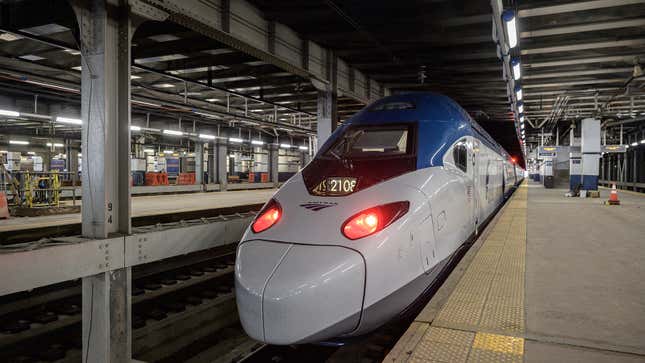America’s railways are rapidly falling behind the rest of the world. Trains are slower, tracks are older and stations are becoming fewer and farther between. Now, rail operator Amtrak is working to change things with a fleet of new high-speed trains, but there’s a problem: the tracks are too old for them to run at full speed.
Amtrak has ordered a fleet of 28 high speed trains that it plans to put into service as early as 2024. When they roll out onto America’s railways, the new trains will cover the Boston to Washington route, where they promise much faster speeds and an improved service. In Europe and the rest of the developed world, high speed rail regularly hits speeds of up to 200mph.
However, when the tech reaches America, it will be limited to “slower than 110 mph in most segments,” according to a new report from Scientific American, and the trains have been designed to only hit a top speed of 160mph. According to the site, this is because the 450-mile route does not currently use modern tracks that can handle the high speeds of the new trains.

This means that president Biden’s ambitious plans for the future of America’s railways could hit a stumbling block. Or, as Scientific American reports, three stumbling blocks.
First is the track, which is too old to handle the speeds of modern trains. On top of that, the current layout doesn’t suit high-speed trains, as it’s packed with sharp turns, old tunnels, overhead power lines and crumbling bridges that can all slow down the trains.
In contrast, high speed routes in countries like Japan and Germany run their fastest trains on specially constructed tracks. Slower trains all run on their own simpler routes.
Then there’s the money needed to fund all this investment that’s meant to get people back onto America’s trains. So far, congress and the Biden administration have not set out a budget for the annual improvements needed to modernize America’s railways, including the cash to produce new tracks and trains here in America.

Which brings us on to, perhaps, the biggest sticking points, which centers around the rail industry in America. Biden’s plans require things like tracks and trains to be built here in the U.S. of A, which could put the brakes on any improvements as “capacity is limited,” as Scientific American reports:
The U.S. lacks a passenger rail industry that can produce all of the parts needed for a high-speed rail system and comply with Buy America. In addition, the tracks, signals, rail cars and software made in the U.S. are costlier than imports, largely because the government has not funded rail the way European and Asian countries have, experts say.
So, while it’s great that we might finally get a few dozen high-speed trains in America next year, it’s not quite the turning point for this great nation’s train travel. Instead, it’ll be a bit like excitedly buying all the ingredients for delicious brownies, only to get home and realize you don’t have an oven. Disappointment for everyone is guaranteed.
Update (8 A.M ET September 7 2023): This story initially stated that the Amtrak trains were designed to reach 200mph but would be unable to hit those speeds in the U.S. However, while high speed rail elsewhere is capable of this, the trains being operated in the U.S. have only been built to hit 160mph.